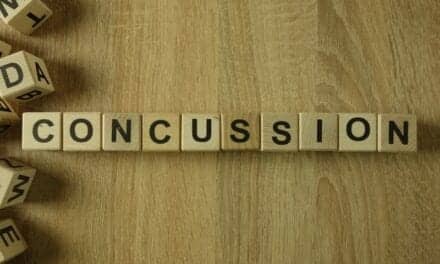by John Gallucci, Jr, MS, ATC, PT, DPT
Injury from sport is a risk that has become commonplace in today’s athletics. Athletes are becoming bigger, stronger, and faster, while the technology to keep them safe has attempted in earnest to keep pace. A key factor in maintaining safety for athletes—and the most critical factor to proper treatment of injury, regardless of type—is early recognition and intervention. This couldn’t be more true than when evaluating a concussion.
A concussion can be defined as a brain trauma with transient neurological symptoms that ripple out with effects on balance, coordination, memory, and ability to concentrate on a task. Signs and symptoms vary since they are dependent on the individual and the manner in which they are outwardly expressed. For instance, one athlete may complain immediately of a mild headache with dizziness and nausea, whereas another may not show any of these signs until days later. Once again, early recognition of potential trauma to the brain is key in safely evaluating and treating concussions.
Classically, the mechanism of injury for a concussion is a direct blow to the head from either an opposing player or an object (ie, baseball, lacrosse ball). This is not always the case, however, as concussive forces can be transmitted through the body either from a fall on the backside, or whiplash, and result in trauma to the brain.
Anatomically, the brain is protected within the skull by cerebrospinal fluid that surrounds the brain and acts as a shock absorber from within. When forces are transmitted to the cranium, tissue damage is seen either on the same side of contact, or on the opposing side, depending on the type of force transmitted. Generally speaking, forces can be described as accelerating or decelerating, in regards to the brain within the skull. Although it is good for a therapist to take note of this during an evaluation, the type of force does not currently hold much relevance on the ensuing treatment. Treatment is dependent on the severity of symptoms subsequent to the initial trauma.
Post-injury Treatment and Care
Once the possible concussion is identified, it is up to those on-site to make sure the athlete is immediately removed from play. Proper treatment of a concussion should initially include adequate rest, followed by a graduated return-to-play protocol under the direction of the sports medicine team, which may include an athletic trainer, physical therapist, and team physician. Communication with parents, coaches, and athletes are all equally important to proper care and guidance.
How is “adequate rest” determined? The appropriate time for rest is dependent on the individual, but always coincides with a resolution of symptoms. A good rule of thumb currently in practice is to sit them out for
1 week. To properly track individual symptoms, a graded symptom checklist is appropriate both pre-injury and post-injury. These measurements are taken at regular intervals (usually daily) to track the symptom progression, and are subjective to the individual.
Unlike injuries to other parts of the body where objective measures can be taken and assessed (ie, range of motion, swelling, deformity), practitioners must rely on these subjective measures for proper assessment. Of course, there are few objective measures, such as pupillary reaction, nystagmus, or loss of consciousness, that are indicative of brain injury, so practitioners must consider congenital defects of the same degree that may be pre-existing.
Concussion Assessment Tools
A few tools available for both on-field and post-injury assessment are available for proper injury tracking. It is my belief that no single tool is greater than the other, but a wide array can be used in conjunction with one another to better frame the athlete’s state of well-being.
The SCAT II (Sport Concussion Assessment Tool) from Inovapp Inc is a quick and effective tool for measuring loss of function post-concussion. It includes portions of the SAC (Standard Assessment of Concussion), the Maddocks questions for sideline concussion assessment, BESS (Balance Error Scoring System), and simple coordination. A score is given based on evaluation of these criteria, but it is ultimately up to the on-field assessor to make the correct call.
ImPACT testing, which is available from Pittsburgh-based ImPACT Applications Inc, is another useful program that analyzes similar criteria. It also includes sections that accurately analyze reaction time, and compares all of this graphically in a side-by-side comparison to a pre-injury baseline test. This test is generally reserved for post-injury assessment away from the field of play, but is useful in determining the severity of impairments.
The King Devick test, manufactured by King Devick Test LLC, Oakbrook Terrace, Ill, is another concussion assessment tool designed for rapid sideline screening of concussions. The test can be administered by coaches, trainers, parents, or medical professionals in less than 2 minutes and can help aid in the detection of concussions and determine whether the athlete should return to play.
Post-Concussion Health Risks
There are a number of risks associated with concussion, namely post-concussion syndrome, second-impact syndrome, and what is being called chronic traumatic encephalopathy. Of course, there has been much coverage in the media about these topics, and new information is constantly being developed. The bottom line is that this is an injury to the brain. We only get one, and we must treat it with care and attention. As stated previously in this article, early intervention is key, and coaches, parents, or professionals can simply live by the phrase, “When in doubt, sit them out.”
The consequences of ignoring such warnings can be lethal. Second-impact syndrome is a condition describing just that. It is seen in adolescents whereby a “second impact” occurs prior to the full recovery of the brain after an initial trauma. The human skull is designed to be the first line of defense, offering a hard protective layer over the brain. Unfortunately, when swelling infiltrates, it has nowhere to go, creating pressure on the brain. Suffering a second trauma without adequate time for the injured and swollen brain to recover from the first is often fatal.
Return-to-Play Protocol
Only one step is completed per day. If concussion symptoms return at any point, the therapist should re-evaluate after
24 hours for symptom resolution. If symptoms have resolved, the athlete can then proceed with the return-to-play protocol beginning at step one. To move forward with the protocol, each step must be successfully completed asymptomatically for a full day. At this point, proper communication should occur with the athlete, athletic trainer, physician, parents, and coaches, to ensure all are on the same page with the protocol—if they’re not already familiar with it.
Step 1: Rest and recover until asymptomatic. Immediate removal from play, and includes a minimum of 1 week out from physical activities. Modifying cognitive activities, such as school and work may also be necessary. Evaluation by a sports medicine professional to identify limitations may be needed, including a follow-up ImPACT test, SCAT II test, BESS, etc. There are multiple tools available, and the consensus is to gain information from different sources to better frame the individuals deficits, and properly instruct a return-to-play protocol.
Step 2: Low-level, nonimpact physical activity (ie, bike, elliptical). Once asymptomatic and cleared by a physician to begin a return to play, the goal is to elevate the heart rate slowly, keeping it at around 70%. This should last approximately 20 to 40 minutes, depending on preconditioning level, and should not exacerbate any concussive symptoms.
Step 3: Elevate heart rate with functional, low-impact activities. Begin with a nonimpact warm-up, similar to what was done in Step 2, and progress to a low-impact jog, side-shuffle, and/or ladder drills. You may even include a small circuit of body weight exercises, including squats, push-ups, and sit-ups. This should last approximately 20 to 60 minutes in duration, with time for rest.
Step 4: Introduce sport-specific athletic activities. The athlete should be brought through a proper warm-up, including lunges, butt-kicks, lateral shuffle, and jogging followed by skills and drills specific to the sport. Plyometrics, PREs (resistance training), agility, and reproduction of demands of the sport. Once successfully completed, a follow-up with the physician is appropriate to clear for noncontact participation in Step 5.
Step 5: Noncontact practice. Begin with 50% activities and avoid situations where contact is involved. The best way to separate athletes is to put them in a different color jersey and alert the team that they are strictly noncontact. The goal here is to acclimate the athlete to game speed and regain confidence.
Step 6: Return to sport. Making sure throughout the protocol there have been no return of symptoms, and the athlete has had adequate time to regain confidence to fully return to play. Clearance should be given by the sports medicine team, including the athletic trainer, physician, parent, coach, and athlete. It is up to the entire team to decide when they feel the athlete has properly been tested and best ready for their return to activity.
Preserving the Safety and Health of Athletes
In summary, educating the public, and compliance with coaches, parents, physicians, and the athlete, are all key components to a safe and successful season. Each athlete is an individual and must be treated as such on a case-by-case basis. Keep in mind that it is always better to sit out and err on the side of caution than to suffer the risks. PTP
John Gallucci, Jr, MS, ATC, PT, DPT, is the medical coordinator for Major League Soccer and president of JAG Physical Therapy, a multilocation outpatient physical therapy company in New Jersey. Gallucci currently serves as a governor-appointed member of the New Jersey Council on Physical Fitness and Sport and has expertise in injury prevention, rehabilitation, sports medicine, and athletic conditioning. For more information, contact [email protected].
Recommended reading from the author: Concussion identification, management and return to play. Medical Advisory Board, April 2010. Web 27 February 27, 2012. Available at: http://www.njsiaa.org/NJSIAA/10ConcussionManagement.pdf. Accessed October 17, 2013.
Product Resources
The following companies offer products for concussion assessment and treatment:
Dynavision International LLC
www.dynavisiond2.com
ImPACT Applications Inc
www.impacttest.com
King-Devick Test
www.kingdevicktest.com
Micromedical Technologies
www.micromedical.com








